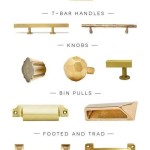How To Adjust Kitchen Cabinet Doors: A Comprehensive Guide
Kitchen cabinet doors, while seemingly simple, play a crucial role in the functionality and aesthetics of a kitchen. Over time, these doors can become misaligned due to various factors, including normal wear and tear, changes in humidity, and the settling of a house. Misalignment can lead to issues such as doors rubbing against each other, not closing properly, or appearing visually unappealing. Therefore, understanding how to adjust kitchen cabinet doors is a valuable skill for any homeowner.
This comprehensive guide details the process of adjusting different types of kitchen cabinet doors, covering common problems and providing step-by-step instructions for achieving proper alignment. The information presented here allows individuals to rectify these issues themselves, saving time and money on professional repairs.
Identifying Common Kitchen Cabinet Door Misalignment Problems
Before attempting any adjustments, it's essential to accurately diagnose the specific problem affecting the cabinet doors. Several common issues contribute to misalignment, each requiring a distinct approach for correction.
One prevalent problem is a door that sags or droops. This usually manifests as the bottom corner of the door being lower than it should be. This often occurs due to the weight of the door and the gradual loosening of the hinges over time.
Another common issue is a door that is not level with its adjacent door or the cabinet frame. This can result in uneven gaps or a visually unappealing appearance. Such problems often stem from hinges that have shifted slightly or from a door frame that is no longer perfectly square.
Doors that rub against each other or the cabinet frame are also common. This can create friction, preventing the door from closing smoothly and potentially damaging the finish. This rubbing often arises from doors being too close together or from a warped cabinet frame.
Finally, a door that doesn't close completely or latches improperly indicates a problem with the alignment or the latching mechanism itself. This could be due to misaligned hinges, a warped door, or a faulty latch. Understanding the precise nature of the problem is the first step in effectively resolving it.
Tools and Materials Required
Preparing the necessary tools and materials before beginning the adjustment process ensures efficiency and minimizes potential delays. The following is a list of essential items:
- Screwdrivers: Both Phillips head and flathead screwdrivers of various sizes are crucial for loosening, tightening, and adjusting screws.
- Level: A level helps determine whether the cabinet and doors are properly aligned, ensuring a professional-looking finish.
- Measuring tape: A measuring tape is necessary for accurately measuring gaps and distances to ensure uniform alignment.
- Shims: Thin pieces of wood or plastic used to fill gaps and provide support where needed to level the cabinets.
- Pencil: Used for marking areas that require adjustment or for noting existing measurements.
- Drill (optional): A drill with appropriate bits can be helpful for tightening loose screws or creating pilot holes for new ones. Be extremely cautious when using a drill to avoid stripping screws or damaging the cabinet frame.
- Wood glue (optional): For reinforcing loose screws or repairing minor damage to the cabinet frame.
Having these tools and materials readily available will streamline the adjustment process and enable effective troubleshooting.
Step-by-Step Guide to Adjusting Different Types of Hinges
The procedure for adjusting kitchen cabinet doors varies depending on the type of hinges used. European-style hinges, also known as concealed hinges, are common in modern kitchens, while traditional face-frame hinges are more prevalent in older kitchens. Below are detailed instructions for adjusting both types.
Adjusting European-Style (Concealed) Hinges
European-style hinges typically have multiple adjustment screws that allow for precise alterations in the door's position. These hinges usually have three axes of adjustment: vertical, horizontal, and depth.
Vertical Adjustment: To adjust the door vertically (up or down), locate the vertical adjustment screw on the hinge. This screw is usually located near the top or bottom of the hinge plate. Loosen the screw slightly and gently move the door up or down until it is level with the adjacent door or the cabinet frame. Once the door is in the correct position, tighten the screw securely.
Horizontal Adjustment: To adjust the door horizontally (left or right), locate the horizontal adjustment screw. This screw is typically positioned on the side of the hinge. Loosen the screw slightly and slide the door left or right until the gap between the door and the cabinet frame is uniform. Ensure that there is no rubbing or interference with adjacent doors. Tighten the screw once the door is in the desired position.
Depth Adjustment: Depth adjustment controls how far the door sits in or out relative to the cabinet frame. Locate the depth adjustment screw, usually found on the hinge arm. Loosening this screw allows the door to be pushed further into the cabinet, while tightening it brings the door further out. This adjustment is crucial for ensuring the door closes flush with the cabinet.
Fine-Tuning: After making these initial adjustments, assess the door's alignment from different angles. Small adjustments may be necessary to achieve a perfectly aligned door. Pay close attention to gaps and ensure they are consistent along the entire perimeter of the door. If problems persist, double-check that the hinge screws are securely tightened and that the hinge plates are firmly attached to the door and cabinet frame.
Adjusting Face-Frame Hinges
Face-frame hinges are typically attached to the front frame of the cabinet and are visible when the door is closed. These hinges may offer fewer adjustment options than European-style hinges, but they can still be effectively adjusted to improve door alignment.
Tightening Loose Screws: The simplest adjustment involves tightening any loose screws on the hinge plates. Over time, screws can loosen due to vibrations and regular use. Use a screwdriver to tighten all screws on both the door and cabinet frame sides of the hinges. If the screws are stripped and unable to tighten, replace them with slightly longer screws of the same diameter. If the screw hole is too large, insert a small wooden dowel and glue into the hole, allow it to dry, and then redrill a pilot hole for the screw.
Shimming Hinges: If tightening the screws does not resolve the misalignment, shimming the hinges may be necessary. Shims are thin pieces of wood or cardboard that can be placed behind the hinge plate to change its angle and thus adjust the door's position. Determine which part of the hinge needs to be moved and place a shim behind the appropriate hinge plate. For example, if the door is sagging, a shim behind the bottom hinge can help lift the door. Experiment with different shim thicknesses until the door is properly aligned.
Adjusting the Hinge Plate: Some face-frame hinges allow for slight adjustments by loosening the screws on the hinge plate and shifting it slightly. This may require creating slightly larger holes in the cabinet frame or door to allow for movement. Exercise caution to avoid damaging the surrounding wood. Once the hinge plate is in the desired position, tighten the screws securely.
Replacing Hinges: If the hinges are severely damaged or corroded, replacing them may be the most effective solution. When replacing hinges, ensure that the new hinges are the same size and type as the old ones to ensure a proper fit. Carefully remove the old hinges and install the new ones, taking care to align them correctly.
Addressing More Complex Alignment Issues
In some situations, simple hinge adjustments may not be sufficient to correct the alignment problems. In these cases, a more thorough assessment of the underlying issues is necessary.
Checking Cabinet Frame Squareness: A warped or out-of-square cabinet frame is a common cause of door misalignment. Use a level to check the vertical and horizontal planes of the cabinet frame. If the frame is not square, shimming the cabinet during installation or adding bracing can help to correct the issue.
Door Warping: If the cabinet door itself is warped, it may be difficult to achieve perfect alignment. Minor warping can sometimes be corrected by clamping the door flat and applying heat from a heat gun or hairdryer. However, severely warped doors may need to be replaced.
Latch Adjustments: If the door closes properly but doesn't latch securely, the latching mechanism may need adjustment. Many cabinet latches are adjustable, allowing you to fine-tune the position of the catch. Loosen the screws holding the catch in place and reposition it until the door latches securely. Ensure that the latch and catch are aligned correctly and that the door closes fully before tightening the screws.
Professional Assistance: In some cases, particularly with complex or long-standing alignment issues, seeking professional assistance from a carpenter or cabinet maker may be the most prudent approach. Professionals have the expertise and tools to diagnose and repair even the most challenging alignment problems.
By following these guidelines and carefully adjusting the hinges and other components, most kitchen cabinet door alignment issues can be effectively resolved, restoring the functionality and aesthetics of the kitchen.

3 Simple Ways To Adjust Kitchen Cabinet Doors Wikihow

How To Adjust Your Kitchen Cupboard Doors Made Easy

Adjusting Cabinet Hinges The Diy Life

How To Adjust 3 Hinges Align Cabinet Doors

How To Adjust Kitchen Cupboard Hinges The Big Idea

How To Adjust Your Kitchen Cabinet Hinges Solid Wood Cabinets Information Guides

3 Simple Ways To Adjust Kitchen Cabinet Doors Wikihow

How To Align Cabinet Doors Home Improvement Contractors Projects

How To Adjust A Door That Rubs Doesn T Shut Or Is Sagging

How To Adjust Kitchen Cabinet Doors
Related Posts








